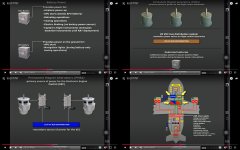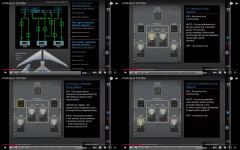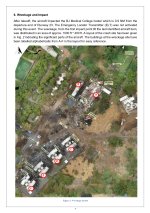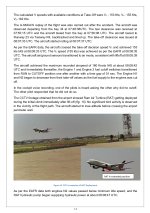Possibility of maintenance issues are there, but it spans numerous things.
But if considering FUEL CONTAMINATION then
Our expectation is that when initial contamination builds up,
at an international busy airport where continous refuelling take place,
it should cause engine sputter/stuter/shudder,
that too in multiple jets,
on multiple days & time,
forcing for maintenance,
not a sudden crash only for 1 jet,
that too late at 1:38 pm local time,
It is analogous to us sneezing, coughing & not straight away dropping dead on floor unless we inhaled nerve gas, cyanide, etc.
Common enthusiasts like us consider contamination as water, paste like dirt, some solid particles but not to the limit of 100% blocking valves, filters, etc, so rapidly in short time, causing complete loss of thrust & crash a vehicle.
In a default scenario, there are S.O.P.s & ISO standards to follow, multiple quality checks, quick checks & elaborated checks.
+ we would expect many filters & quality checks at every step used while transfering fuel from beginning till end -
- refinery to transport tanker
- transport tanker to airport storage
- airport storage to fuelling tanker
- fuelling tanker to aircraft
Captain Steve in his videos & statements said the fuelling trucks have contamination detection mechanism.
BUT, i realized that depending upon contaminant, catastrophic faults can be fast in 1st flight or span multiple flights.
So if those fuel giants are so careless then it would be a scam of unprecedented scale.
Citizens might stop taking fuel from them, their shares in stock market will collapse, the company or subsidiary might go bankrupt.
Each GenX-1B engine has -
- Fule Metering Unit
- LP & HP pumps
- LP & HP filters
View attachment 44589
View attachment 44590
So contamination should cause pressure & flow irregularities recorded by FMU (Fuel Metering Unit), forcing for maintenance.
IDK the Black Box contains data of how many flights.
The data can be recorded in redundant bit level for max data.
If it has last few flights data then irregulaties will be recorded there.
While discussing on other forum, I came across 2 examples of contamination on different jet models & different bludner mistakes of adding 38x fuel-additive biocide & bad construction practices of fuel storage area. it is worth to have a lookat them:
Cathay Pacific Flight 780, 13 April 2010,
Airbus A-330,
Surabaya, Indonesia, to Hong Kong International Airport
(Cathay Pacific Flight 780 - Wikipedia)
View: https://www.youtube.com/watch?v=lPeZr9uSfTg
RAT was manually, proactively deployed.
In flight they had chance to use APU also.
Left engine N1 ran at 74% & right engine N1 at 17%.
The root cause was bad construction practice during rain leading to salt water getting into fuel pipe, reacting with filter & releasing SAP particles.
View attachment 44591
View attachment 44592
View attachment 44593
View attachment 44594
===============================================================
Titan Airways, Airbus A321,
24 Feb 2020, Cyprus - London, no errors !!!!!!.
25 Feb 2020, London - Gatwick, On ground for left engine -
HP Fuel valve warning, engine took 2 attempts to start.25 Feb 2020, Gatwick - Balice (Poland), no errors !!!!!!
26 Febl 2020, Balice (Poland) - Gatwick, On ground for left engine -
2 times HP Fuel valve warning, engine stall warning once,left engine took 3 attempts to start, momentary errors in flight & thumping sound after landing.26 Feb 2020, Gatwick - London, On ground for left engine -
ignitor fail alert, engine fail alert 2 times, engine took 4 attempts to start, incident on take-off,Fortunately the engines didn't fail completely & the jet could turn around & land,
thumping sound after landing.
View: https://www.youtube.com/watch?v=E4Qclymu2EA
This one happened due to multiple mistakes, that too on ground before 1st & 2nd flight & ultimately in 5th flight during takeoff -
- Language barrier in Cyprus, not understanding what is PPM (Parts Per Million).
- Wrong calculation & 38x quantity of Kathon biocide over-use & concentration in HMU, not due to algae.
- As per re-enacted animation it seems that biocide was added improperly from top access port, not mixed well with proper tools, leaving sludge on bottom & tank outlet, went into HMU & choked it. Hence right engine started but left engine took 4 attempts to start on ground.
- Before next flight the ground engineer referred to troubleshooting by fault code rather than engine model, hence of wrong engine.
- & no boroscope inspection was done.
View attachment 44595
View attachment 44596
View attachment 44597
View attachment 44598
///////////////////////////////////////////////////////////////////////////////////////////////
> These incidents happened either mid-flight, means issues took time to manifest.
Or in 2nd example, many engine start faults happened on ground bcoz it is a unique series of blunder mistakes, but then ultimately in 5th flight during T/o.
> In these 2 cases both the engines did not cease but ran at low RPMs due choking of piston of FMU (Fuel Metering Unit) & valve of HMU (Hydro Mechanical Unit).
While in case of AI-171 the pilot's Mayday call reported something like "no thrust, no power, losing lift, going down", speculating 0% RPM.
So, for AI-171 we've to look at -
- maintenance records,
- maintenance areas
- historical warning messages also in Black Box apart from latest.
Rethinking about contamination -
Chemistry is such a tricky aspect of nature, it is difficult to proactively discover all chemical reactions.
The 2 examples we discussed were very educating -
- The excess biocide example, spanned across 5 flights, with errors in flight & on ground, yet the A/c survived.
- The salt water reacting with filter & releasing polymer particles jamming the FMU valve, within 1 flight itself, the flight surviving fortunately.
In a tropical country, during summer season, a possible contamination would have different reasons, most likey with poor maintenance.
But we don't know yet about historical maintenance records of AI-171 airframe, the H/w issues or the S/w alerts if any.
So on this angle we've to assume something similar to 2nd example of salt water causing full fuel contamination & rapid reaction within 1 flight, so much rapid that the problem didn't occur mid-flight but immediately after take-off.
What kind of chemical reaction can take place in fuelling chain -
- causing only 1 flight,
- impacting both engines same time,
- around mid-day noon,
- when local flights would depart in morning,
- probably taking fuel from same source?
Either it should be internal to airframe, or to the fuelling truck.
I checked some YT videos of fuel filter & pump in GenX-1B engine & found that there are multiple rings for sealing joints, just like in our kitchen pressure cooker.
I wonder if a reaction can take place here.



I couldn't find pic/vid of 787 fuel tank fuel pump. Perhaps it might little bigger but identical to this one i found - of A320.

















 when
when




















